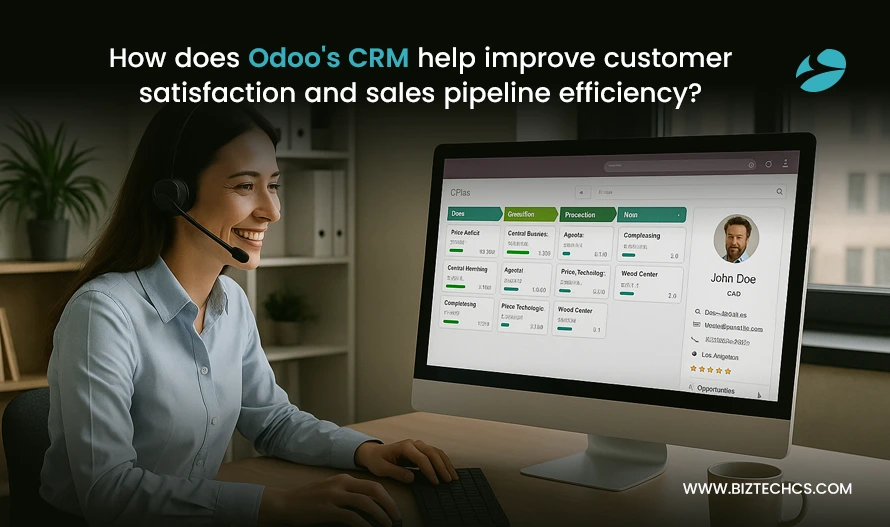1248
How does Odoo’s CRM help improve customer satisfaction and sales pipeline efficiency?
07 Aug, 2025
5 min read
1248
07 Aug, 2025
5 min read
Table of Content

Let’s start with something you’ve probably experienced—but would rather not repeat.
It’s 3 AM. Your phone lights up. It’s the operations team. There’s a stock issue, and they can’t trace it. Your warehouse manager is juggling half-updated Excel sheets, handwritten delivery notes, and urgent WhatsApp messages from different branches. Nothing adds up, everyone’s scrambling, and you already know this will spiral by morning.
Now, picture this scenario—because it happens more often than you might think.
You’re running a company like Gulf Industrial Supplies in Dubai. A well-established player in the market. You’ve scaled from a small family operation to a team of over 200 employees. Your footprint spans major infrastructure projects across Abu Dhabi, Riyadh, and beyond.
But while your business has grown, your systems haven’t kept up.
Each branch continues to manage operations using its own spreadsheets. Procurement is buried in long email threads. Inventory updates are inconsistent and often require manual intervention. Real-time visibility across warehouses, currencies, and VAT jurisdictions? Nearly impossible.
Then comes the wake-up call.
During a routine audit, you discover a discrepancy of AED 2.3 million between your physical stock and your financial records. In the UAE, where VAT compliance demands full traceability, and in Saudi Arabia, where e-invoicing regulations are tightening rapidly, this isn’t just inefficient—it’s a serious legal risk.
Here’s what the data shows: 55–75% of ERP implementations fail to meet their objectives, and cost overruns average 189% (source).
The problem isn’t just picking the wrong ERP. The real issue is implementation—when businesses try to “plug in” a system without aligning it with their actual workflows, compliance obligations, and regional complexities.
This is where the approach needs to be different.
Before you even think about software, your first step should be to map out your cross-border transactions and compliance obligations. As of 2024, in the GCC, the UAE’s standard VAT rate is 5%, while Saudi Arabia’s is 15%, each country having its own rules for exemptions, zero-rating, and tax treatment of exports (source.).
Well, Platforms such as Odoo are built to manage these complexities.
With proper configuration, Odoo effectively handles multi-jurisdictional tax rules by utilizing built-in fiscal positions, automated mappings, and rule-based tax logic. But none of that matters if the system is set up reactively—after your audit flags the gaps. Compliance isn’t something to fix later; it must be designed into operations from day one.
If you’ve been struggling with VAT mismatches, manual processes, or visibility gaps across your supply chain, this is the opportunity to address them before they become a crisis.
With the right strategy, Odoo isn’t just an ERP. It becomes the backbone of compliant, scalable, and fully integrated operations, built for growth across borders.
When you walk into a client’s headquarters, the first thing you often encounter is skepticism, especially from the CFO, who might ask:
“We’ve looked at several ERP vendors, and they all promise the same thing. What makes your approach different?”
Here’s what you’d explain:
BiztechCS can implement ERP solutions with a deep understanding of where Odoo’s out-of-the-box modules excel, and where strategic customizations can be applied for a competitive edge. Another common concern from finance heads is: “How quickly can we expect measurable ROI if we invest in Odoo?”
The answer: most clients see tangible results in the first three months, such as reduced month-end closing cycles, better inventory accuracy, and fewer emergency purchases. This fast return on efficiency proves the system is not just a cost but a growth enabler.
BiztechCS can start with Odoo’s Inventory Management and Accounting modules as these perform exceptionally well without needing customizations. Odoo’s inventory engine can handle multi-location, multi-currency, and multi-company scenarios reliably, and BiztechCS can seamlessly integrate barcode functionality, automated reorder rules, and real-time stock valuation to ensure smooth operations, even in complex warehouse networks.
Odoo Consultant Tip: Always configure Odoo’s reordering rules based on both minimum stock levels and vendor lead times. This prevents stockouts in high-demand projects and ensures your procurement team doesn’t over-purchase during seasonal demand spikes.
Now, here’s where a bit of strategic customization really shines.
Imagine having real-time visibility across warehouses in Dubai, Abu Dhabi, and Jeddah—and achieving it within just two weeks. Say a project manager in Riyadh requests 500 steel beams.
With this setup, the system would instantly show available stock across all locations, pending purchase orders, and expected delivery dates, while correctly calculating VAT implications for cross-border transfers.
However, this is where the implementation strategy truly shines.
During the first month, procurement heads often raised a common concern: ‘What about our existing supplier relationships and pricing agreements? We can’t just disrupt twenty years of carefully built partnerships.’ That’s when the approach shifted. At this point, another question often comes from operations leaders: “Will migrating to Odoo force us to abandon all of our current workflows overnight?”
No, not at all. BiztechCS maps existing workflows into Odoo first, ensuring the system mirrors current business realities before introducing gradual improvements. This minimizes disruption while building trust across teams.
Instead of forcing immediate change, Odoo’s vendor management was configured to mirror current supplier hierarchies and pricing structures. Then, gradual process improvements were introduced as internal confidence built. The system adapts to the business reality, not the other way around.
Odoo Consultant Tip: During supplier migration, avoid importing only active vendors. Import the full vendor history into Odoo and tag them by category (active, inactive, or preferred). This gives procurement leaders full visibility into historical supplier performance and pricing trends.
This strategy also involves setting up separate fiscal positions for each jurisdiction and utilizing Odoo’s automated tax calculation engine to ensure VAT is calculated based on the partner’s location and registration status. This eliminates the manual VAT errors that often derail GCC implementations, making cross-border transactions seamless.
In short, it’s never just about the software. It’s about tailoring the implementation to align with your current operations, while leaving room for long-term improvement and reducing risk at every step.
Struggling with month-end reconciliation headaches? Discover how self-auditing inventory foundations cut errors, save time, and give finance teams full confidence in the numbers.
In the construction supply business, where vendor relationships are crucial, managing hundreds of suppliers across multiple countries can easily lead to procurement chaos. Adding the complexity of ensuring compliance with each jurisdiction’s regulations gives you a full-time headache.
Here’s a question for procurement leaders: What do you do when a supplier in Saudi Arabia isn’t VAT-registered, but your purchases exceed the mandatory VAT registration threshold? This is a real-life scenario that often goes unnoticed —and one reason generic ERP solutions fail to meet GCC business needs.
BiztechCS can optimize procurement with Odoo’s Purchase Module by making procurement smarter, more streamlined, and fully compliant with regional requirements. Procurement directors often ask: “How does Odoo handle compliance when we’re working with suppliers across multiple jurisdictions?”
Our approach includes configuring supplier master data with VAT registration details, compliance certificates, and real-time validation rules. This ensures every purchase order meets regional regulations without manual checks, protecting you from penalties while streamlining operations.
Odoo Purchase Module – Native Capabilities,
But here’s where it gets interesting. The off-the-shelf Odoo Purchase Module can cover a lot, but when it comes to GCC business realities, there’s a need for strategic customizations that address local challenges head-on.
Our Strategic Customizations:
BiztechCS will configure the system to automatically flag potential compliance risks before they escalate, even handling complex VAT treatments based on the supplier’s location and VAT registration status. This will ensure compliance, reduce risk, and streamline procurement operations for your business.
A solid example of this is how we use Odoo’s purchase workflows, adding a layer of custom logic for supplier master data that includes VAT registration details and compliance certificates. The system utilizes custom procurement logic to ensure that every purchase order is compliant with the supplier’s jurisdiction and VAT registration thresholds. By building this validation directly into the workflows, we help businesses avoid last-minute surprises and maintain a smooth, compliant process.
We typically see significant improvements by month six, including,
However, perhaps the most significant change is in how procurement teams can shift their focus from firefighting administrative tasks to nurturing strategic relationships with suppliers. The system handles the compliance complexities, allowing your team to focus on what truly matters.
By tailoring Odoo’s workflows to meet the unique needs of the GCC market, we enable businesses to be more proactive, efficient, and ultimately, more profitable. So, if you’re in procurement and facing the challenges of multi-country, multi-regulation supply chains, this approach is a game-changer.
Planning to expand your ERP across the Gulf? See how proactive compliance mapping prevents costly setbacks and ensures smooth, regulation-ready rollouts.
BiztechCS can enhance the customer experience and accelerate revenue growth by leveraging Odoo CRM and Sales modules, taking your operational foundation to the next level.
BiztechCS will implement a customer portal for self-service order tracking and document access, automate pricing with customer-specific terms, and enable opportunity tracking with automated follow-ups. The integration between quotes, orders, and invoices will ensure seamless document management, improving the overall customer experience and revenue outcomes.
Odoo Consultant Tip: When setting up Odoo CRM, enable automated activity scheduling (calls, follow-ups, emails) tied to opportunity stages. This ensures no lead slips through the cracks, while also giving sales managers real-time visibility into pipeline health.
Project managers could log into a customer portal to check real-time order status, view detailed delivery schedules, and access digital copies of compliance certificates. But here’s where our understanding of B2B construction dynamics would make the difference.
Sales directors often ask us: “What about our complex project-based pricing and long-term contracts? We have tiered pricing based on annual volume commitments, project-specific discounts, and multi-currency contract terms.” Another frequent question from commercial managers is: “How does CRM integration improve customer satisfaction in practical terms?”
The answer: by giving customers access to a self-service portal with real-time order tracking, compliance documentation, and accurate pricing. This reduces quote turnaround from days to hours, boosts order accuracy, and ensures clients feel in control—driving higher retention rates.
This complexity is exactly why we build such solid operational foundations first. The system would manage all of these pricing variations while maintaining accurate margin visibility for management. But more importantly, CRM integration reveals insights that were previously invisible.
We typically see these customer satisfaction improvements,
Here’s something interesting we often uncover: Integrated systems reveal payment pattern insights that enable proactive cash flow management and informed credit decisions. Have you ever wondered why some customers consistently pay late while others pay early? The data tells the story, but you need integrated systems to see it.
Odoo’s customer portal framework is exceptionally flexible out of the box. We configure it to display compliance documentation alongside order history and create custom document templates for VAT certificates. Using Odoo’s automated workflow engine to deliver e-invoicing documents seamlessly, the portal becomes a competitive differentiator when properly configured.
Worried about migrating from spreadsheets and losing critical data? See how sandbox testing ensures smooth, secure migrations with zero disruption to your operations.
BiztechCS can help companies meet the financial reporting and regulatory compliance challenges of GCC ERP implementation within just twelve months.
BiztechCS will configure Odoo to handle complex reporting requirements, including ZATCA-compliant invoice formats for Saudi e-invoicing mandates, ensuring that the system maintains detailed audit trails required by Saudi authorities. This setup will make compliance smooth and efficient, meeting regulatory demands while enhancing financial intelligence.
Odoo Consultant Tip: Always set up separate fiscal positions for each VAT jurisdiction in Odoo before going live. This avoids retroactive corrections, reduces audit risks, and ensures accurate compliance reporting from day one.
This is a forward-thinking ERP implementation. We don’t just solve today’s problems—we build architecture that accommodates tomorrow’s regulatory changes.
We can typically deliver this financial transformation value:
But the strategic breakthrough comes with management reporting. For the first time, leadership would have real-time visibility into profitability by customer, project, product category, and geography. This is usually where CEOs or managing directors ask: “How does this system help us make faster strategic decisions?”
By integrating financial, operational, and sales data into one platform, Odoo provides instant insights—such as profitability per project or market entry costs in new regions. Instead of relying on fragmented spreadsheets, leadership can make decisions backed by real-time numbers, not assumptions.
Odoo Consultant Tip: Configure Odoo dashboards to display KPIs by project, customer, and geography. This turns Odoo from a transactional system into a decision-making engine, giving CEOs and CFOs the insights they need without waiting for manual reports.
Odoo’s accounting engine handles multi-company scenarios brilliantly, but GCC compliance requires strategic configuration. We set up separate journal sequences for each VAT jurisdiction while maintaining a consolidated chart of accounts for group reporting. We build automated inter-company elimination rules and currency conversion workflows. The key is treating compliance as system architecture, not bolt-on functionality.
According to Panorama Consulting Group’s 2025 ERP Report, average ERP project timelines have dropped to nine months. Organizations that prioritize process improvement and real-time data-driven decision-making are seeing stronger business benefits.
BiztechCS can drive measurable business impact and deliver sustainable growth through a strategic ERP implementation. Eighteen months after starting an ERP journey, companies evolve from operationally focused distributors into strategically managed growth companies. The transformation isn’t just about software—it’s about building business capabilities that enable intelligent decision-making and sustainable scaling.
Data flowing through integrated Odoo systems powers strategic decisions that would have been impossible before. When major infrastructure projects open opportunities in Qatar, management could instantly model the financial impact: required inventory investment, supplier relationship requirements, regulatory compliance costs, and expected profitability timelines.
Should you establish operations in Qatar or serve the market from your UAE base? This strategic question could be answered with data rather than intuition.
After 18 months, BiztechCS will achieve the following outcomes for your business,
But here’s what BiztechCS wants you to remember: industry studies show that failed ERP implementations often result from poor planning rather than software limitations. BiztechCS’ methodology demonstrates that success comes from treating ERP as a business capability, not just a technology installation.
BiztechCS can answer the critical questions you have when evaluating potential ERP partners.
When you partner with BiztechCS, we will leverage Odoo’s native capabilities while implementing strategic customizations as needed. Our extensive experience with GCC compliance will ensure a seamless implementation that meets local regulations. BiztechCS will also focus on transferring knowledge to your team, empowering them for long-term independence. With BiztechCS’ guidance, you will achieve measurable business outcomes within just six months.
These aren’t vendor qualification questions—they’re strategic implementation questions. The difference matters.
Our approach proves that understanding which Odoo modules work brilliantly out-of-the-box—and where targeted customization creates competitive advantage—makes the difference between implementation success and expensive failure.
Are you shipping modular furniture or managing construction supplies? Discover how GCC-compliant Odoo implementations create growth-ready operations with built-in efficiency and control.
Odoo’s CRM improves customer satisfaction through self-service portals with real-time order tracking, automated document delivery, and integrated compliance certificates. BiztechCS implementations achieve 97% order accuracy, reduce quote turnaround from 2 days to 2 hours, and reach 84% customer portal adoption within 3 months—driving higher retention rates through transparency.
Yes. BiztechCS configures Odoo CRM to manage tiered pricing based on annual volume commitments, project-specific discounts, and multi-currency contract terms while maintaining accurate margin visibility. The system automates pricing calculations with customer-specific terms, eliminating manual errors and enabling instant quote generation.
Odoo CRM integration with accounting modules exposes payment behavior insights previously invisible in spreadsheets. The system tracks which customers consistently pay early versus late, enabling proactive cash flow management and informed credit decisions—turning relationship data into strategic financial intelligence.
BiztechCS delivers measurable Odoo results within 3 months (reduced month-end closing, better inventory accuracy) and full implementation within 18 months. Month 1 focuses on foundation modules, month 6 delivers procurement intelligence, and by month 12 financial reporting is fully automated—with revenue growth averaging 34% year-over-year post-implementation.
Odoo integration provides real-time visibility into profitability by customer, project, product category, and geography. When evaluating Qatar expansion, management instantly models required inventory investment, supplier relationships, regulatory compliance costs, and profitability timelines—making data-driven decisions instead of gut-feeling guesses.

Odoo
80
By Uttam Jain
18 Nov, 2025

Artificial Intelligence (AI)
108
By Afzal Qureshi
18 Nov, 2025

Odoo
122
By Uttam Jain
13 Nov, 2025